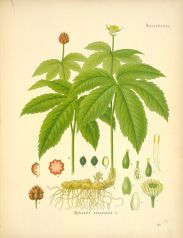Goldenseal's Golden Season
By Audrey Stallsmith

To Native Americans and newcomers to the continent, goldenseal was a folk medicine staple. . .
James Duke, The Green Pharmacy Herbal Handbook
Once known as "poor man's ginseng," goldenseal has, unfortunately, become almost as rare and pricey as ginseng itself. Originally a home remedy that settlers learned from their Native American neighbors, the wild plant was simply referred to as yellow root, ground raspberry, wild curcuma, or yellow puccoon.
(Native Americans called several of their dye plants "puccoon". Bloodroot, for example, was known as red puccoon. Those dyes colored clothing--as well as war paint!)
Herbalist Samuel Thomson apparently thought the traditional titles not flashy enough, because he changed the plant's name to goldenseal. Its root scars are supposed to resemble the decorative seals once used to stamp warm wax onto envelope flaps.
Thomson had some strange beliefs, one being that disease was caused by loss of body heat and could be expelled by hot baths, cayenne, and emetics (herbs that cause vomiting). But his remedies probably did less harm than the literal blood-letting popular with "real" doctors at the time!
Thomson peddled his message mainly to the lower classes who couldn't afford physicians. The 19th-Century Eclectics, however, attempted to reform medicine from within. They gave goldenseal its more highbrow name: Hydrastis canadensis. Hydrastis derives from the Greek "water" and "to accomplish"-perhaps in reference to goldenseal's ability to thin mucous. Canadensis means "Canadian," although, the herb was native to much of the eastern United States as well.
The price of this natural antibiotic jumped to $1 per pound around the time of the Civil War and has never stopped climbing. Goldenseal's popularity probably lies in the fact that it is an all-purpose healer. James Duke, author of The Green Pharmacy, explains that the berberine in the herb activates white blood seals that kill off bacteria, fungi, viruses, and even tumor cells.
It is much gentler on the stomach than modern antibiotics too. In fact, goldenseal soothes the intestines and stimulates bile to improve digestion. (It may kill off friendly bacteria too, though, so don't use it any longer than necessary.)
Goldenseal inevitably became a popular ingredient in patent medicines and that as inevitably led to its depletion in the wild. Also, ever since a novel falsely implied that goldenseal would conceal the presence of illicit drugs in the urine, it has been a favorite of junkies too!
Although goldenseal won't really help the over-drugged conceal their habit, it will treat a wide variety of maladies-basically any that are caused by bacteria, fungi, viruses, or tumor cells! That includes colds, influenzas, sinusitis, pneumonia, bladder infections, earaches, canker sores, sties, and vaginitis. Amish herbalist, Emma Byler, recommends goldenseal for soothing sore throats and itches and cleaning wounds.
The dried leaves are generally less expensive than the more potent root. Also, there are several other wild plants that contain berberine. They include barberry (Berberis vulgaris), Oregon grape (Berberis aquifolium), goldthread (Coptis trifolia), and yellowroot (Xanthorhiza simplicissima).
Some of these are bound to be cheaper than goldenseal, but please do research their edibility before trying any of them. Goldenseal itself can be toxic in high doses, so I suspect some of the others can as well. Pregnant women shouldn't take any of them, since berberine may also cause contractions of the uterus.
These days, goldenseal is often grown by the same people who raise ginseng. Both plants require similar conditions, after all (well-drained, woodland-type soil and high shade). Since seed germination is difficult, those growers often purchase 2-year rhizomes to plant and harvest them 3 years later.
Anything as slow-growing as that, is, of course going to cost you. So the "golden" in the name, which originally referred to the color of the herb's root, has become much more literal. These days we self-sufficient country types may either have to grow our own or find a cheaper substitute. Barberry, anyone?
Hydrastis canadensis image is from Kohler's Medizinal-Pflanzen, courtesy of the Missouri Botanical Garden.








